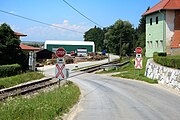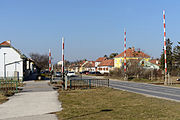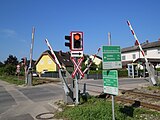Level crossing (Austria)
Railway crossing (abbreviation: EK) officially denotes a public level crossing in Austria . The regulations for securing and translating are set out in the Railway Crossing Ordinance (EisbKrV) . The number of level crossings has been greatly reduced in recent decades. While there were around 10,700 in 1960, there were only around 3,300 at the end of 2017.
The road users are notified of level crossings with appropriate traffic signs . In principle, single or - in the case of multi-track level crossings - double St. Andrew's crosses are set up at every public level crossing.
The type of securing of the level crossing is determined in a procedure according to § 49 EisbG by the competent authority on the basis of the local conditions and the volume of traffic on road and rail.
Not technically secured level crossings
A level crossing that is not technically secured is ensured by ensuring the required viewing area (Section 35 EisbKrV), by emitting acoustic signals from the rail vehicle (Section 36 EisbKrV) or by guarding (Section 39 EisbKrV). Road users are given a not technically secured level crossing, depending on the local conditions and the type of security, in addition to the Andrew's cross with the danger sign "level crossing without barriers", beacons, stop signs, additional signs (e.g. "pay attention to the whistle signal"), or the like. announced. In addition, local speed limits for road traffic can be prescribed in the EK area.
The maximum speed at which a rail vehicle may approach a level crossing that is not technically secured is 80 km / h.
Technically secured level crossings
Technically secured level crossings are used where, due to the local conditions and the traffic conditions on rail and road, safe operation without technical means cannot be guaranteed. At all technically secured level crossings there are at least four traffic lights for road traffic. Additional signaling devices and, if necessary, additional equipment (e.g. ringing acoustics) are specified in the procedure in accordance with Section 49 EisbG. Individual systems with old signaling for road traffic are still in use (road signaling devices with red flashing lights and systems with bells without traffic lights), but these must be replaced or abandoned by systems with yellow and red road signaling devices by the end of 2029 at the latest (Section 102, Paragraph 3 EisbKrV).
Closing of a mechanical barrier with chime in Fels, 2012
When a technically secured level crossing is switched on, according to the EisbKrV, a continuous yellow light appears for four seconds, then a continuous red light. This stop requirement, which begins with the lighting up of the yellow light, applies until the red signal heads go out again. Because of a possible restart of the system shortly thereafter, e.g. B. by another train on a double-track line, an early translation is life-threatening and also punishable.
A distinction is made between technical fuses
- Security through light signals (Section 37 EisbKrV) and
- Safety through light signals with barriers (§ 38 EisbKrV)
Security by light signals
The level crossing may be secured with traffic lights up to a maximum speed of rail traffic of 140 km / h. In addition, the local conditions and the traffic conditions on the road must permit appropriate security. Traffic lights are announced in addition to St. Andrew's crosses with the danger sign "level crossing without barriers", beacons, etc.
The term traffic light system is used in the Austrian railway law and must not where he worked for the traffic light (in Austria be confused with the same term in Germany, traffic signal is used) on the road.
Security by light signals with barriers
When using light signals with barriers, a basic distinction is made between protection using light signals with half barriers and protection using light signals with full barriers. A half barrier blocks the right half of the road, a (multi-part) full barrier blocks the entire road. The maximum speed for rail traffic in the area of a traffic light system with barriers is 160 km / h. Before the barrier booms are closed, the road signaling devices are switched on with a corresponding, so-called pre-lighting time, with a 4-second continuous yellow and then red continuous light. Here, too, translating the level crossing before the red signal head goes out is a criminal offense. For road traffic, traffic lights with barriers are announced in addition to the St. Andrew's crosses with the danger sign “level crossing with barriers”, beacons, or the like. In Austria, due to serious accidents, additional lighting, so-called lane lights , have been installed since 2007 , which are let into the lane and are intended to attract more attention: This is also done using LED variable message signs that represent an autonomous warning system with vehicle detection and control software.
Monitoring and signal dependency
The proper condition of a level crossing safety system (EKSA), which was built according to the EisbKrV 2012, must be shown in a monitoring body or in a covering signal. This ensures through operational or technical processes that no train approaches in the event of a faulty EKSA.
Driver monitoring
This is where the EKSA is monitored by the driver. An EKÜS (level crossing monitoring signal) is set up on the length of the braking distance of the rail vehicle, which informs the driver with the signal - EK allowed to drive on - that the EKSA is not disturbed and has switched on properly or will be switched on. In the case of a disturbed EKSA, the signal - EK allowed to drive on - goes out, the traction vehicle can be brought to a standstill before the EK.
Remote monitoring
A remotely monitored EKSA can, depending on the technical equipment of the EKSA or the interlocking, be monitored via a safe display or via dependent covering signals. In the case of an interlocking with a safe display or a safe signaling desk, the dispatcher must ensure that none of the systems following the signal is disturbed before the signal is released.
If, on the other hand, the EKSA is switched to the opaque signals (signal-dependent), the affected signals cannot be released in the event of a fault in a subsequent EKSA.
Assumption of costs for construction work
Basically, for each of these points, a cost allocation of 50 percent to the railway company and to the carrier of the road construction work (mostly the municipality ) is provided, if no prior agreement ( RIS ) was in place. However, both parties are entitled to submit a request for cost sharing. In these cases, the cost-sharing mass and its allocation is determined based on four aspects:
- Change in traffic since planning permission for the intersection
- Improving the handling of rail and road traffic
- savings
- Additional expenses in the special interest of a mode of transport
The corresponding apportionment procedure and the associated weightings led to two administrative court judgments in 2019. In its first judgment on the subject in May 2019, the VwGH decided that the cost of securing the ice rink crossing is increasingly borne by the bearer of the road construction load. The reason is an attribution to "improve the handling of traffic". This judgment could result in significant additional work for the municipalities. In the second ruling, in June 2019, the VWGH decided that if the security system is renewed (e.g. light signals), the municipality does not have to bear any costs, provided that the municipality did not bear any costs for the existing security system the type of backup does not change.
Traffic signs
Extract from the picture table of the traffic signs in Austria
Historical
Older types of signaling devices at level crossings without barriers had a triangular shape, as shown in the illustration on the right. Under the two red alternating flashing lights, a white flashing light used to indicate that the system was in operation. The changed legislation made this warning obsolete and removed the white light spots and closed the corresponding openings.
To make it easier to recognize approaching trains, so-called barrier propellers , as they exist in other countries , were also used in the past . The first of these rotors was set up at a level crossing in Unterwaltersdorf in November 1959.
Individual evidence
- ↑ Federal Law Gazette II No. 216/2012 : Railway Crossing Ordinance 2012.
- ↑ ÖBB Security Offensive accessed on July 31, 2019
- ↑ Pilot project with lane lights in Wieselburg
- ^ BMVIT Verkehrssicherheit State Prize 2009 from March 18, 2010, accessed on March 23, 2010.
- ^ Construction site level crossing analysis by Bernhard Haubenberger in the local authority on July 18, 2019
- ↑ The first barrier propeller turns . In: Arbeiter-Zeitung . Vienna November 21, 1959, p. 5 , below ( berufer-zeitung.at - the open online archive - digitized).























